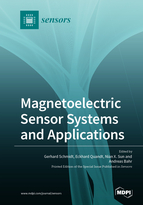Magnetoelectric Sensor Systems and Applications
A special issue of Sensors (ISSN 1424-8220). This special issue belongs to the section "Physical Sensors".
Deadline for manuscript submissions: closed (11 December 2021) | Viewed by 36448
Special Issue Editors
Interests: signal processing; biomedical applications; real-time systems
Interests: magnetoelectric materials; magnetoelectric sensor concepts
Interests: magnetoelectric materials; magnetoelectric sensor concepts; magnetoelectric antennas
Special Issues, Collections and Topics in MDPI journals
Interests: magnetoelectric materials; magnetoelectric sensor concepts; low- noise and low-power design; biomedical signal acquisition
Special Issues, Collections and Topics in MDPI journals
Special Issue Information
Dear Colleagues,
Well-established magnetic sensors such as superconducting quantum interference devices (SQUIDs) or optically pumped magnetometers (OPMs) have several advantages if magnetometers are used either in addition or sometimes instead of electric measurements. Application examples include spatially and temporally high-resolution medical analysis such as combined electro- and magnetoencephalography (EEG/MEG), electro- and magnetocardiography (ECG/MCG), or structural material analysis. The drawbacks of current magnetic sensor technologies are mainly their high cost and their limited robustness against environmental influences. External magnetic fields, such as the magnetic field of the earth or the fields created by power supplies, saturate sensor principles and expensive magnetic shielding and sometimes expensive cooling are required. The magnetoelectric (ME) sensor principle is relatively new and has the potential to overcome these limitations at a very low cost. Recent advances, in terms of magnetic layer optimization, low-noise readout, and dedicated signal processing for new read-out principles, might enhance the sensitivity of magnetoelectric sensor principles and bring them very close to that of OPMs or SQUIDs without robustness problems.
This Special Issue will report the latest research on magnetoelectric sensor systems and corresponding applications. The bandwidth of contributions can range from advances in material science and improved understanding of the magnetic processes that are involved in magnetoelectric layers, low-noise amplification circuits, and specially tailored readout schemes for ME sensors, but also application examples from biomedical or other fields.
Prof. Dr. Gerhard Schmidt
Prof. Dr. Eckhard Quandt
Prof. Dr. Nian X. Sun
Prof. Dr. Andreas Bahr
Guest Editors
Manuscript Submission Information
Manuscripts should be submitted online at www.mdpi.com by registering and logging in to this website. Once you are registered, click here to go to the submission form. Manuscripts can be submitted until the deadline. All submissions that pass pre-check are peer-reviewed. Accepted papers will be published continuously in the journal (as soon as accepted) and will be listed together on the special issue website. Research articles, review articles as well as short communications are invited. For planned papers, a title and short abstract (about 100 words) can be sent to the Editorial Office for announcement on this website.
Submitted manuscripts should not have been published previously, nor be under consideration for publication elsewhere (except conference proceedings papers). All manuscripts are thoroughly refereed through a single-blind peer-review process. A guide for authors and other relevant information for submission of manuscripts is available on the Instructions for Authors page. Sensors is an international peer-reviewed open access semimonthly journal published by MDPI.
Please visit the Instructions for Authors page before submitting a manuscript. The Article Processing Charge (APC) for publication in this open access journal is 2600 CHF (Swiss Francs). Submitted papers should be well formatted and use good English. Authors may use MDPI's English editing service prior to publication or during author revisions.
Keywords
- magnetoelectric sensors
- magnetic sensor concepts
- sensor system development
- biomedical applications










